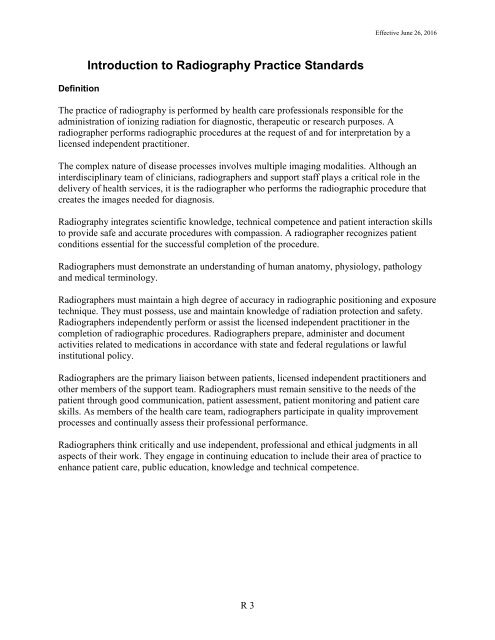ASRT_professional_standards_practices
Create successful ePaper yourself
Turn your PDF publications into a flip-book with our unique Google optimized e-Paper software.
Effective June 26, 2016<br />
Definition<br />
Introduction to Radiography Practice Standards<br />
The practice of radiography is performed by health care <strong>professional</strong>s responsible for the<br />
administration of ionizing radiation for diagnostic, therapeutic or research purposes. A<br />
radiographer performs radiographic procedures at the request of and for interpretation by a<br />
licensed independent practitioner.<br />
The complex nature of disease processes involves multiple imaging modalities. Although an<br />
interdisciplinary team of clinicians, radiographers and support staff plays a critical role in the<br />
delivery of health services, it is the radiographer who performs the radiographic procedure that<br />
creates the images needed for diagnosis.<br />
Radiography integrates scientific knowledge, technical competence and patient interaction skills<br />
to provide safe and accurate procedures with compassion. A radiographer recognizes patient<br />
conditions essential for the successful completion of the procedure.<br />
Radiographers must demonstrate an understanding of human anatomy, physiology, pathology<br />
and medical terminology.<br />
Radiographers must maintain a high degree of accuracy in radiographic positioning and exposure<br />
technique. They must possess, use and maintain knowledge of radiation protection and safety.<br />
Radiographers independently perform or assist the licensed independent practitioner in the<br />
completion of radiographic procedures. Radiographers prepare, administer and document<br />
activities related to medications in accordance with state and federal regulations or lawful<br />
institutional policy.<br />
Radiographers are the primary liaison between patients, licensed independent practitioners and<br />
other members of the support team. Radiographers must remain sensitive to the needs of the<br />
patient through good communication, patient assessment, patient monitoring and patient care<br />
skills. As members of the health care team, radiographers participate in quality improvement<br />
processes and continually assess their <strong>professional</strong> performance.<br />
Radiographers think critically and use independent, <strong>professional</strong> and ethical judgments in all<br />
aspects of their work. They engage in continuing education to include their area of practice to<br />
enhance patient care, public education, knowledge and technical competence.<br />
R 3

















